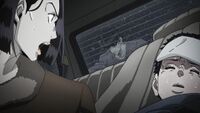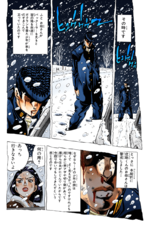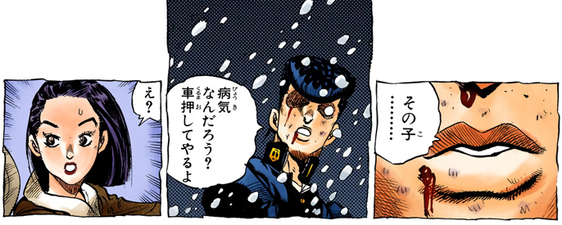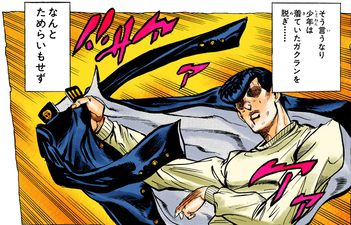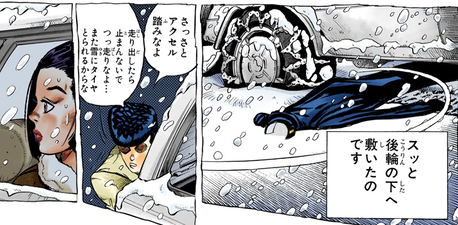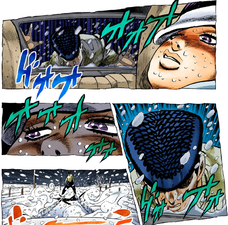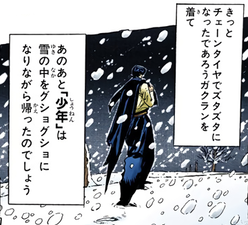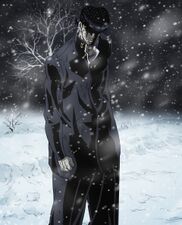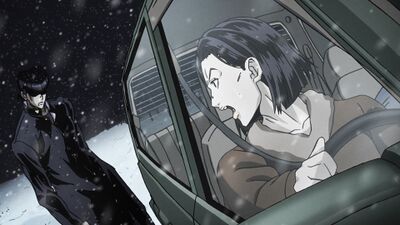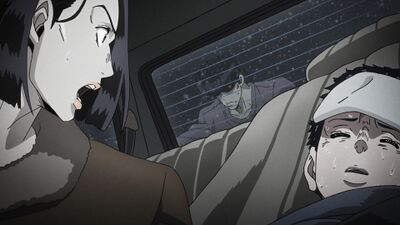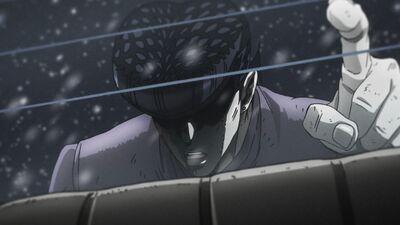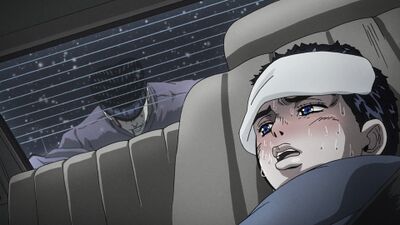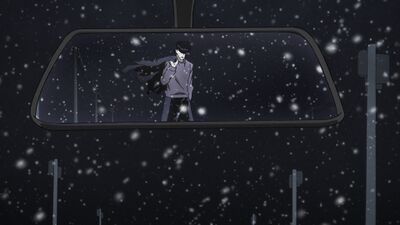Sauveur de Josuke
Jump to navigation
Jump to search
 Apparition dans le Manga
Apparition dans le Manga
 Apparitions dans l'Anime
Apparitions dans l'Anime
 Citations
Citations
“
Il est malade, n'est-ce pas ? Laissez-moi pousser la voiture ?
”
—Sauveur de Josuke, Chapter 324: Let's Go to the Manga Artist's House, Part 7
Le Sauveur de Josuke (仗助の恩人, Jōsuke no onjin) est un personnage tertiaire figurant dans la quatrième partie de JoJo's Bizarre Adventure, Diamond is Unbreakable. Il était un mystérieux jeune lycéen qui a aidé un jeune Josuke Higashikata et sa mère Tomoko à s'échapper d'un blizzard.
Apparaissant sans crier gare, ce jeune homme a aidé les Higashikata en poussant leur voiture et en les débloquant de la neige. Josuke, voyant à peine l'homme, en vient à imiter son pompadour pour lui rendre hommage.
Apparence
The boy has a pompadour hairstyle and a delinquent's school uniform. His jacket is styled with three vertical metallic stripes on the left side of his collar and a metallic emblem with vertical holes inside on the right side. Beneath his school jacket, he wears a sweater with long sleeves.
Palettes
Les palettes changent souvent entre les médias. L'information ci-dessous ne devrait pas être considérée comme canonique.
Manga CouleurAnime
Skin(Fair)
Hair(Black with blue highlights)
Outfit
(Blue uniform with golden-yellow pins and a cream sweater.)
Skin(Pale)
Hair(Black with blue highlights)
Outfit
(Blue uniform with golden-yellow pins and a purple sweater.)
Personnalité
Based on the boy's appearance in Josuke's flashback, he is an empathetic and perceptive individual. Although it was a dark night, the boy could tell that Josuke was sick in the back of Tomoko's car. He voluntarily helps them move their car out of the snow despite being in a rough state with several fresh bruises and open cuts on his face. He also sacrifices his school jacket, which is considered his badge of honor, underneath the car's tires without any hesitation.[1]
Histoire
Passé
For unknown reasons, the young man had just been in a fight with several fresh bruises and open cuts. He stood alone in the middle of a blizzard on a country road with no houses for more than a kilometer in any direction.
Josuke was four years old at this time and came down with a strong fever resulting from DIO activating his Stand, causing the Stands in the Joestar family to activate as well. His mother tried to drive him to the hospital but the car's tires lodged themselves in the snow during a blizzard. Suddenly, this young man wearing a school uniform appeared and was noticed by Tomoko peering into their car through her rearview mirror. Initially wary, she told the boy to go away. However, the young man noticed Josuke was sick and helped them by placing his jacket in front of the car's rear tires and then pushed their car out of the snow. The student then retrieved his now-shredded jacket and walked away never to be seen again. Josuke took a glance at him and saw his hairstyle while he was pushing the car. For the next fifty days while he was unconscious with his fever, Josuke would dream of the boy.
Tomoko attempts to find the boy but does not succeed. Since then, Josuke replicates his hairstyle as homage to his hero, and aspires to become someone who would save others like the young man.[1]
The Book: 4th Another Day
The information below derives from a source not written by Araki. As such, it may or may not be considered canon.
The boy is mentioned in the light novel, 4th Another Day. Takuma Hasumi heard rumors that Josuke modeled his hairstyle after the boy. For Josuke, it wasn't the act of helping another human being that had moved him. What made the student's act resonate with him was that the boy sacrificed what had clothed him in a blizzard to get Josuke and Tomoko's car moving. To Josuke, this act was as holy as a line from a sacred text.
Takuma declares that he should have seen the boy at some point when he was five years old, as Takuma had passed by the four year old Josuke and his mother several times in town, and also has knowledge of every citizen living in Morioh. Takuma was certain that he had memorized the faces of every high school student back then and that this student with a pompadour hairstyle like Josuke should be particularly easy to find using his Stand.
However, Takuma had no intention of actually searching for the student. To catch Josuke off guard during their battle, Takuma suggests that the boy was probably Josuke himself who somehow time traveled in a bizarre way.[2]
Chapitres / Episodes
Chapitres (ordre chronologique)
- Chapter 324: Let's Go to the Manga Artist's House, Part 7 (Flashback(s))
Episodes (ordre chronologique)
- Diamond is Unbreakable Episode 15: Let's Go to the Manga Artist's House, Part 2 (Flashback(s))
Citations
- “He's sick isn't he? I'll push your car.”—Josuke's Savior, Chapter 324: Let's Go to the Manga Artist's House, Part 7
- “Hit the gas. As soon as you're free, keep gunning it. Slow down, and you'll get stuck in the snow again.”—Josuke's Savior, Chapter 324: Let's Go to the Manga Artist's House, Part 7
Galerie
Détails
- L'identité du sauveur de Josuke est un sujet de débat dans le fandom de la série, qui date depuis la publication originale dans le Weekly Shonen Jump.[3]
- Dans une entrevue avec le réalisateur de l'OAV, Hiroyuki Kitakubo, ce dernier a révélé que quand il a parlé à Hirohiko Araki à ce sujet, il a répondu, "Celà n'a rien à voir, c'est juste un souvenir de Josuke".[4]
- Le réalisateur de l'anime produit par David Production, Naokatsu Tsuda, a aussi posé la question à Araki sur ce sujet durant la production, mais Araki aurait refusé d'en parler.[3]
- Dans l'adaptation anime de la partie 4, personne n'interprète les dialogues du sauveur de Josuke. De fait, ils sont affichés sur l'écran avec un texte, comme dans un vieux film muet.
- Dans JoJo's Bizarre Adventure: Adventure Battle Card, on l'appelle le jeune homme dans la neige (雪の中の青年, Yuki no naka no seinen).
Références
- ↑ 1.0 1.1 Chapter 324: Let's Go to the Manga Artist's House, Part 7
- ↑ The Book: JoJo's Bizarre Adventure 4th Another Day Chapter 4
- ↑ 3.0 3.1 DU Episode 15, Naokatsu Tsuda, Blu-Ray limited edition commentary
- ↑ Kitakubo Special Talk (July 1994)
